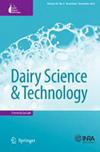Valorization of Concentrated Dairy White Wastewater by Reverse Osmosis in Model Cheese Production
Q2 Agricultural and Biological Sciences
引用次数: 1
Abstract
Treatment of dairy white wastewater (WW) by reverse osmosis (RO) is usually performed to generate process water and to reclaim dairy components for their valorization. For this study, a mixture of pasteurized milk and WW from a dairy plant was concentrated by RO to achieve a protein concentration similar to that of skimmed milk. Retentates, which are concentrated WW, were used in the preparation of cheese milk. The effect of using model concentrated WW was evaluated on (1) the soluble–colloidal equilibrium between protein and salt, (2) the milk-coagulation kinetics, and (3) the cheese composition and yield. An economic assessment was also carried out to support the decision-making process for implementing a new RO system in a dairy plant for the valorization of dairy WW. The results showed that substituting more than 50% of the amount of cheese milk with model pasteurized WW concentrates decreased the moisture-adjusted cheese yield and impaired the coagulation kinetics. Excessive cheese moisture was observed in cheeses that were made from 50% and 100% model WW concentrates, correlating with a change in the soluble–colloidal equilibrium of salts, especially in calcium. To achieve sustainable and economic benefits, the ratio of added WW concentrates to cheese milk must be less than 50%. However, for such an investment to be profitable to a dairy plant within 0.54 years, a large-size plant must generate 200 m3 of WW per day with at least 0.5% of total solids, as the economic analysis specific to our case suggests.反渗透法处理模拟奶酪生产中浓缩乳白废水的研究
通过反渗透(RO)处理乳白色废水(WW)通常用于产生工艺水并回收乳制品成分以使其增值。在本研究中,通过反渗透浓缩了来自乳制品厂的巴氏杀菌奶和WW的混合物,以获得与脱脂奶相似的蛋白质浓度。保留剂是一种浓缩的WW,用于奶酪奶的制备。采用模型浓缩WW对(1)蛋白质和盐之间的可溶性胶体平衡,(2)牛奶凝固动力学,(3)奶酪成分和产量的影响进行了评价。还进行了经济评估,以支持在奶牛厂实施新的RO系统的决策过程,以实现乳制品WW的增值。结果表明,用模型巴氏杀菌的WW浓缩物代替超过50%的奶酪奶会降低水分调节奶酪的产量,并破坏凝固动力学。在由50%和100%模型WW浓缩物制成的奶酪中观察到过量的奶酪水分,这与盐的可溶性-胶体平衡的变化有关,特别是钙。为了实现可持续发展和经济效益,WW精料在奶酪奶中的添加比例必须小于50%。然而,根据本案例的具体经济分析,要使这样的投资在0.54年内对乳制品厂产生盈利,大型工厂必须每天产生200立方米的WW,至少占总固体量的0.5%。
本文章由计算机程序翻译,如有差异,请以英文原文为准。
求助全文
约1分钟内获得全文
求助全文
来源期刊

Dairy Science & Technology
农林科学-食品科技
CiteScore
2.30
自引率
0.00%
发文量
0
审稿时长
2 months
期刊介绍:
Information not localized
 求助内容:
求助内容: 应助结果提醒方式:
应助结果提醒方式:


